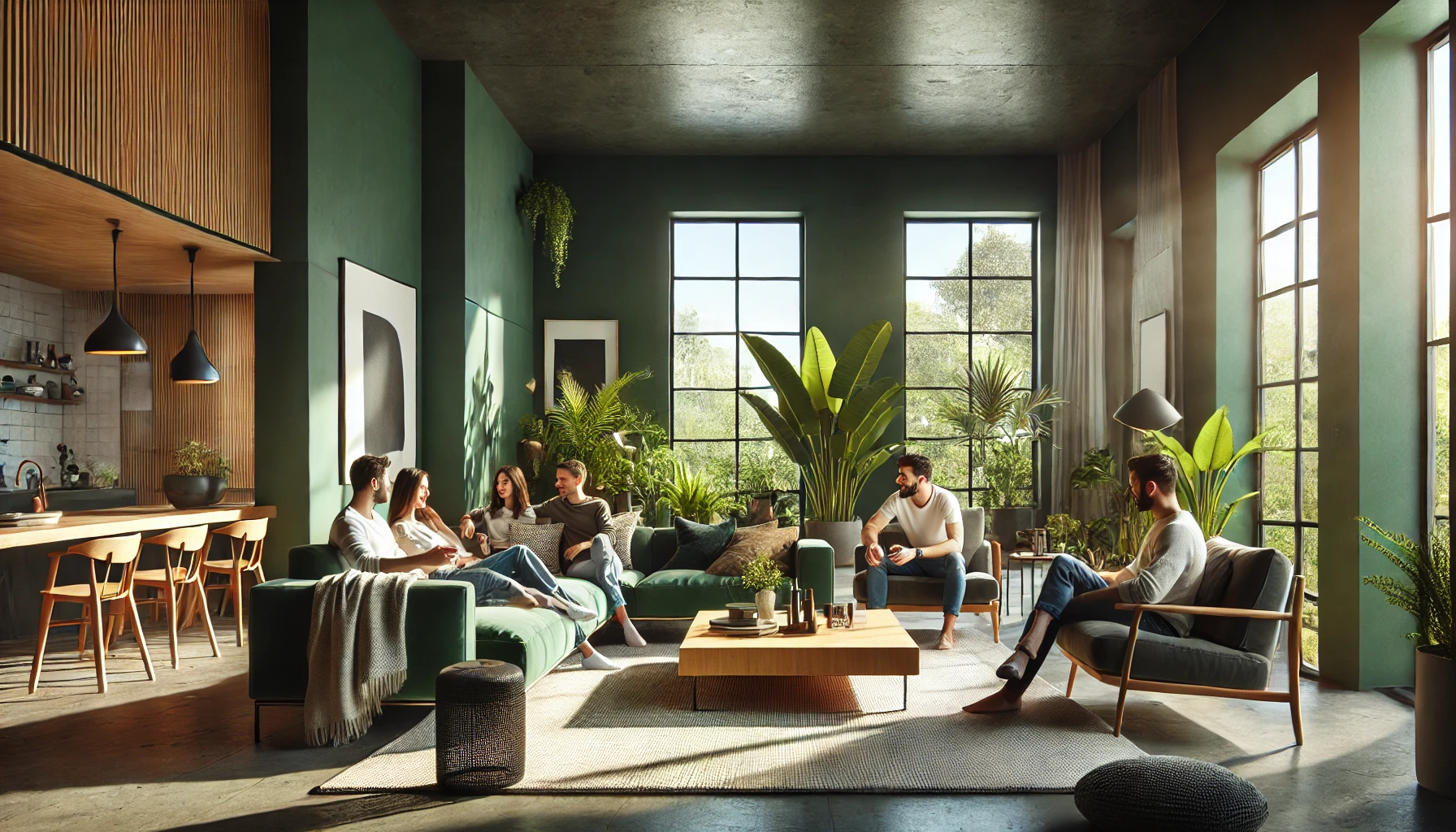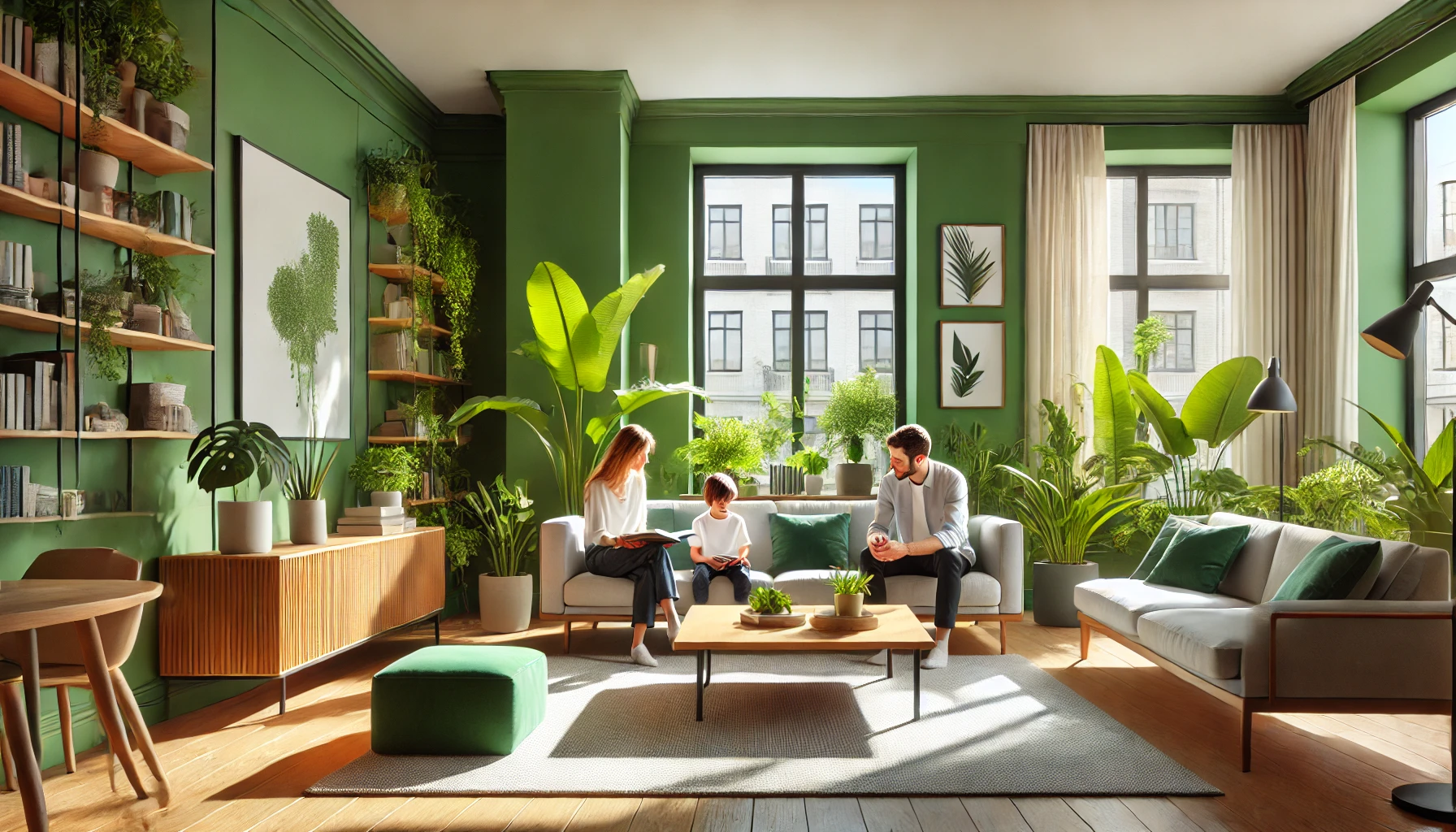In today’s fast-paced world, creating a tranquil and harmonious home environment has never been more essential. One design trend that is rapidly gaining popularity is living rooms green walls—a fusion of nature and modern aesthetics that transforms indoor spaces into serene, vibrant havens.
Green walls, also known as vertical gardens or living walls, are not just visually stunning; they also offer a range of physiological and emotional benefits. From improving air quality to reducing stress, these lush installations are redefining contemporary interior design.
This article explores the myriad benefits of green walls, how they enhance living spaces, and ways to harmoniously integrate them into your home’s decor.
The Benefits of Green Walls in Living Rooms
Environmental Benefits
Green walls serve as natural air purifiers, absorbing toxins and releasing oxygen, making indoor air healthier to breathe.
They can help regulate indoor temperature by providing insulation, reducing energy consumption, and lowering cooling costs during warmer months.
Additionally, these walls contribute to noise reduction, absorbing sound waves and minimizing echo, creating a more peaceful and serene indoor environment.
Air Quality Improvement
The presence of live plants in an indoor setting significantly improves air quality. Studies have shown that plants help eliminate airborne toxins such as formaldehyde, benzene, and carbon monoxide.
A NASA study on air-purifying plants found that incorporating greenery indoors can lead to a cleaner, fresher atmosphere. This is particularly beneficial for urban dwellers who may be exposed to pollutants and allergens.
Psychological and Aesthetic Benefits
Green is widely recognized as a color that induces relaxation and mental well-being. Incorporating a green wall into your living room can enhance mood, reduce stress, and promote a sense of calm.
Research in environmental psychology suggests that exposure to nature, even in an indoor setting, can boost productivity, creativity, and emotional stability.
Beyond psychological benefits, green walls add depth and visual interest to a space, creating a striking focal point that complements various interior styles.
Design Harmony: Pairing Green Walls with Other Elements
To maximize the impact of a green wall in your living room, it’s essential to consider complementary colors, materials, lighting, and decor elements.
Thoughtful design choices can elevate the overall ambiance and ensure that your green wall integrates seamlessly with the rest of your decor.
Complementary Colors and Decor Styles
Green walls pair beautifully with a variety of color palettes. Neutrals like beige, gray, and white allow the green to take center stage, creating a fresh and airy atmosphere.
Earthy tones, such as terracotta, rust, and mustard, enhance the natural appeal of a living wall, giving the space a warm and inviting feel. For a bold and modern look, contrast green with deep blues or charcoal for a sophisticated touch.
In terms of decor styles, green walls work well in contemporary, minimalist, and rustic settings. Scandinavian-inspired interiors benefit from the organic simplicity of greenery, while bohemian styles embrace the lush, layered look that green walls naturally offer.
In modern and industrial spaces, green walls soften the starkness of metal and concrete elements, adding warmth and vitality.
Incorporating Natural Materials and Textures
To enhance the organic appeal of a green wall, integrate natural materials such as wood, stone, and rattan into your living room design.
Wooden furniture, reclaimed wood paneling, and stone accent walls complement the natural aesthetic of a green wall while adding texture and depth. Woven rugs, linen upholstery, and ceramic accessories further reinforce an earthy, nature-inspired ambiance.
Lighting to Accentuate Green Walls
Proper lighting is crucial to maintaining a thriving green wall while accentuating its beauty. Natural light is ideal, so positioning a green wall near a window can provide the necessary sunlight for plant growth.
For spaces with limited sunlight, consider LED grow lights that mimic natural daylight and promote plant health.
Additionally, ambient lighting such as recessed lights, track lighting, or wall sconces can highlight the lush texture and vibrancy of a green wall, making it a focal point of the room, even at night.
Accessorizing with Art, Furniture, and Plants
To create a cohesive and stylish living room, choose furniture and accessories that enhance the natural elegance of a green wall. Neutral or earth-toned sofas, wooden coffee tables, and woven baskets create a harmonious balance.
Artwork featuring botanical prints or nature-inspired themes can further amplify the greenery’s impact. Additionally, incorporating potted plants in varying heights and styles throughout the room complements the vertical garden and reinforces a biophilic design approach.
The Effect of Green on Living Room Ambiance
When it comes to interior design, color plays a crucial role in setting the mood and atmosphere of a space. Green, often associated with nature, tranquility, and renewal, is an increasingly popular choice for living room decor.
But is green the right color for your living room? Let’s explore its impact on ambiance and how it can transform your space.
Is Green a Suitable Color for Living Rooms?
Green is known for its calming and balancing properties, making it an excellent choice for a room where relaxation and socialization occur.
Unlike bold reds or stark whites, green offers a sense of harmony, making it ideal for various home styles. It evokes feelings of serenity and freshness, which is particularly beneficial in spaces meant for unwinding.
The Versatility of Green Shades in Interior Design
One of the standout features of green is its versatility. From deep emerald to soft sage, there is a shade to suit every design preference.
- Dark Greens (Emerald, Forest, Hunter): Ideal for creating a luxurious, sophisticated ambiance, these shades pair well with gold accents and velvet textures.
- Mid-tone Greens (Olive, Moss, Mint): These tones offer warmth and balance, making them great for a cozy, welcoming living space.
- Light Greens (Sage, Seafoam, Pistachio): Perfect for a fresh and airy look, lighter greens reflect more light, enhancing a room’s brightness.
Transforming Small and Large Spaces with Green
Whether you have a spacious living area or a compact lounge, green can be used strategically to optimize space perception.
- Small Living Rooms: Lighter shades of green can make a compact space feel open and refreshing. Pairing with white or neutral tones enhances the sense of openness.
- Large Living Rooms: Darker shades like emerald or hunter green can add depth and sophistication, preventing an expansive room from feeling too empty or cold.
Choosing the Right Shade of Green for Your Style
Selecting the right green depends on your personal style and the overall aesthetic of your home.
- Modern Minimalism: Opt for soft sage or muted olive with sleek furniture and natural materials.
- Bohemian Chic: Earthy greens like moss and avocado combined with wooden textures and bold prints.
- Classic Elegance: Deep emerald green walls with gold or brass fixtures for a regal touch.
- Scandinavian Simplicity: Pale green with light wood and neutral accents for a fresh, clean look.
Sustainability Meets Style: Are Green Walls Still Trending?
Over the years, green walls, or vertical gardens, have evolved from a niche design choice to a mainstream home decor trend. But are they still relevant today?
The Evolution of Green Walls in Home Design
Green walls gained popularity in the early 2010s as homeowners sought to bring more nature indoors. Originally a luxury feature, they have now become accessible through DIY solutions and innovative materials like preserved moss and modular plant panels.
Are Green Walls Here to Stay?
Experts believe that green walls remain a strong trend due to their aesthetic appeal and environmental benefits. They not only enhance air quality but also provide a sense of well-being by incorporating natural elements into home design.
Examples of Contemporary Green Wall Designs
- Living Plant Panels: Modular systems featuring ferns, ivy, and other greenery.
- Moss Walls: Preserved moss offers a low-maintenance alternative with a striking visual impact.
- Herb Gardens: Functional green walls with herbs like basil and mint for a stylish and practical touch.

Expert Opinions on Sustainable Home Trends
Interior designers and sustainability advocates agree that biophilic design, which integrates natural elements into living spaces, is more than just a passing trend.
With the growing awareness of environmental issues, green walls and other nature-inspired designs are expected to remain relevant in the years to come.
Practical Tips for Implementing Green Walls in Your Living Room
If you’re inspired to add a green wall to your living room, here’s how you can do it efficiently.
Step-by-Step Guide to Creating a DIY Green Wall
- Choose a Location: Select a wall that gets sufficient indirect light.
- Select a Frame: Use a wooden frame, a trellis, or a modular panel for plant arrangement.
- Pick Your Plants: Opt for low-maintenance plants such as pothos, ferns, and philodendrons.
- Install an Irrigation System: Consider a simple drip irrigation system or manual watering setup.
- Monitor Growth: Trim and replace plants as needed to maintain a lush appearance.
Budget-Friendly Green Wall Alternatives
- Peel-and-Stick Artificial Greenery: Provides the visual appeal without maintenance.
- Hanging Planters: A cost-effective way to achieve a vertical garden look.
- Repurposed Wooden Shelves with Potted Plants: A simple yet elegant solution.
Maintenance Tips for a Healthy Green Wall
- Choose the Right Plants: Opt for species that thrive indoors.
- Ensure Proper Drainage: Overwatering can lead to mold and mildew.
- Provide Adequate Light: Some plants may require supplemental grow lights.
- Regular Pruning: Keep plants from overgrowing and maintain a neat appearance.
Expert Advice on Plant Selection
Interior gardening specialists suggest plants like spider plants, peace lilies, and ferns for low-light conditions, while herbs and succulents work well in bright areas.
Final Thoughts
Green is a transformative color that brings a sense of balance, freshness, and elegance to any living room.
Whether through paint, furniture, or a stunning green wall, incorporating shades of green can elevate your home’s ambiance.
With sustainability being a growing focus in interior design, green walls continue to be a stylish and eco-friendly addition to modern living spaces.
Whether you opt for a DIY version or a professionally installed setup, green walls are a timeless way to infuse nature into your home.


Green walls in living rooms are such a great way to enhance both the aesthetic and environmental quality of a space. I think the combination of plants and natural elements like wood or stone creates a balanced, welcoming atmosphere. I’m particularly interested in how these green walls can improve air quality and reduce stress. It’s also impressive how versatile green walls can be with different designs, from lush plant panels to herb gardens. Does anyone have recommendations for plants that are particularly low-maintenance but still thrive indoors?
That’s such a great perspective! Green walls truly do transform a living space, both visually and functionally. For low-maintenance indoor plants that thrive in green walls, you might want to consider pothos, snake plants, ferns, and peace lilies—they’re resilient, require minimal care, and help improve air quality. Spider plants and philodendrons are also great choices for their adaptability and air-purifying benefits. If you’re looking for something a bit different, herbs like mint, thyme, or oregano can add both greenery and functionality to your space. What kind of design are you envisioning for your green wall?